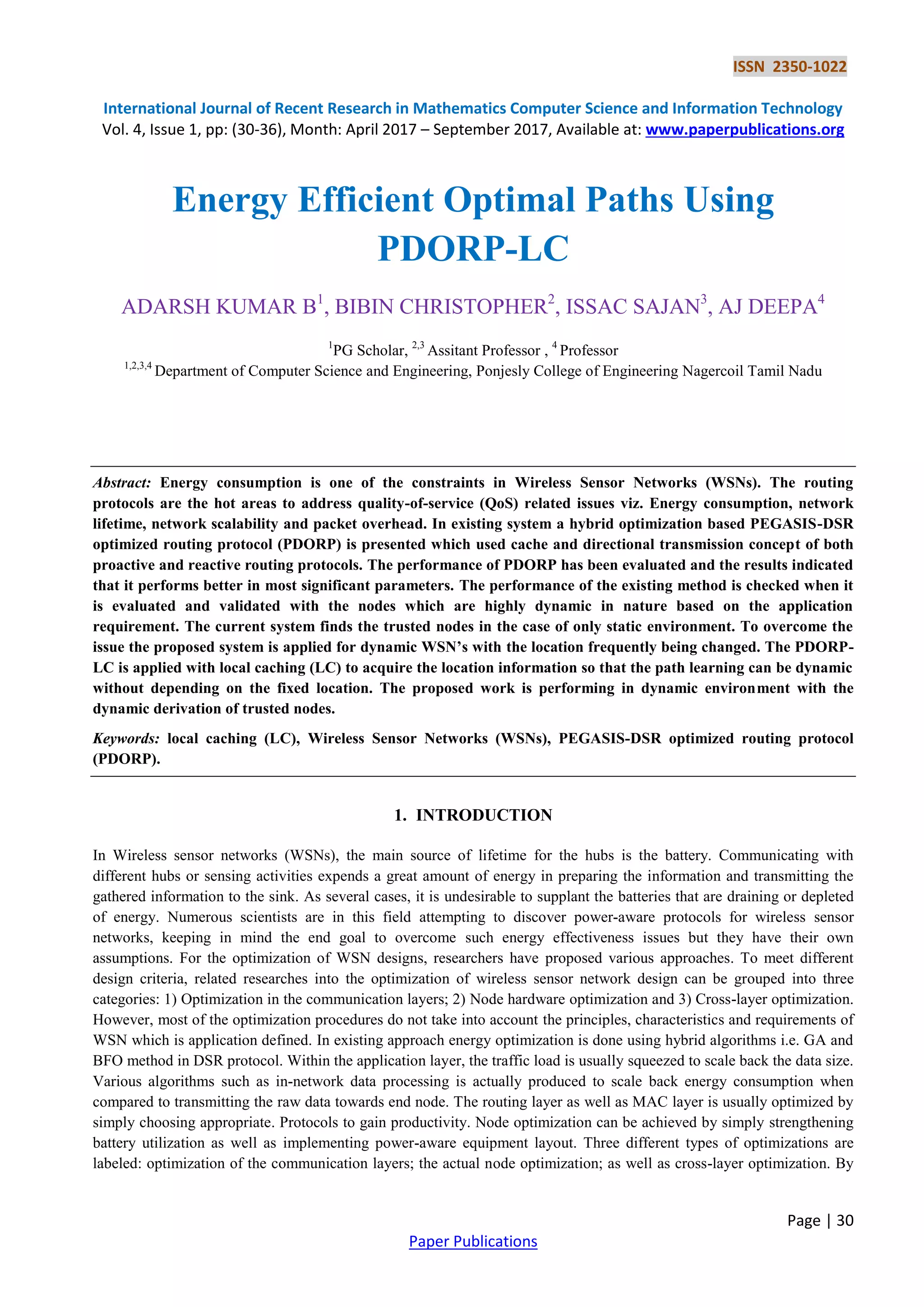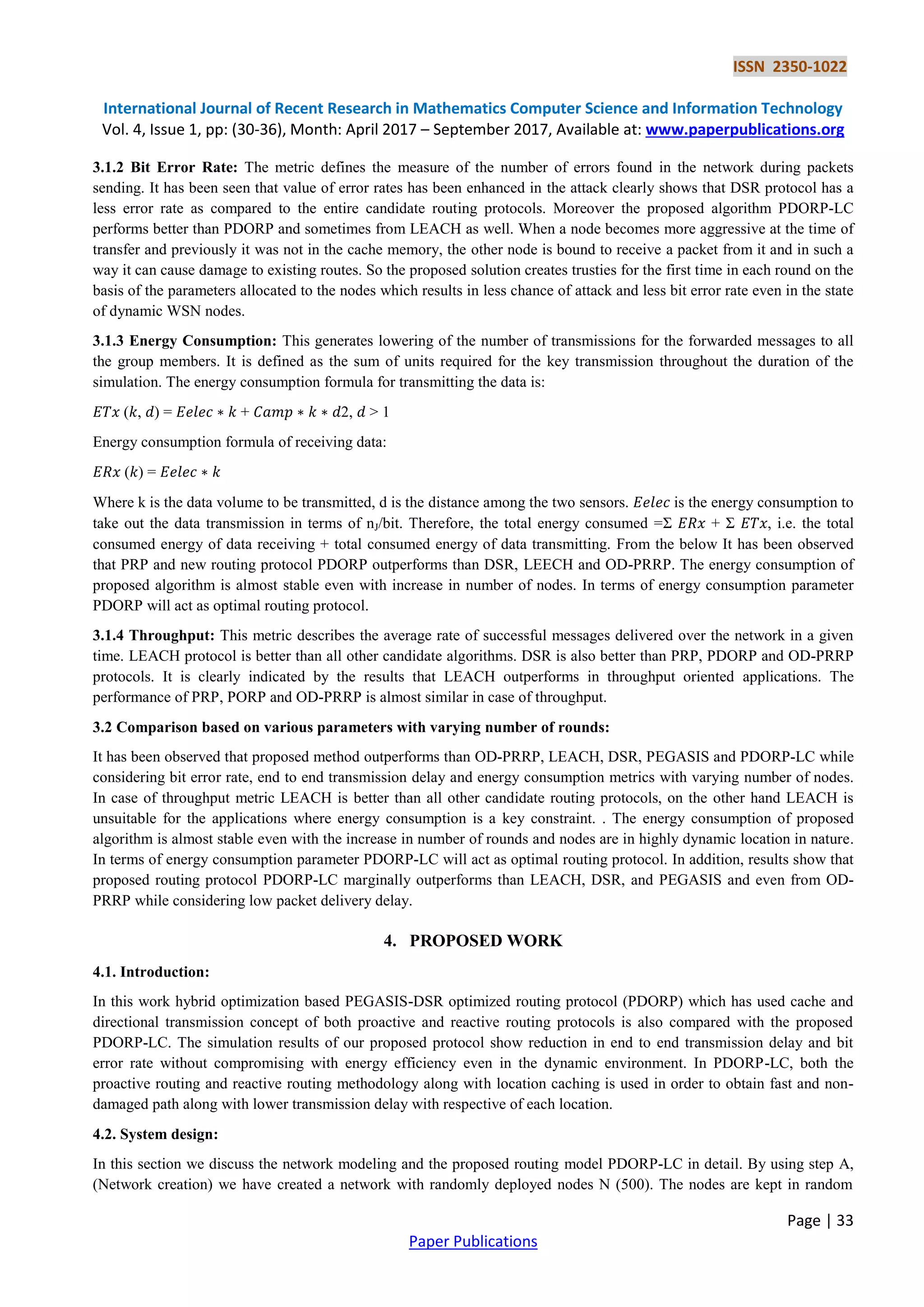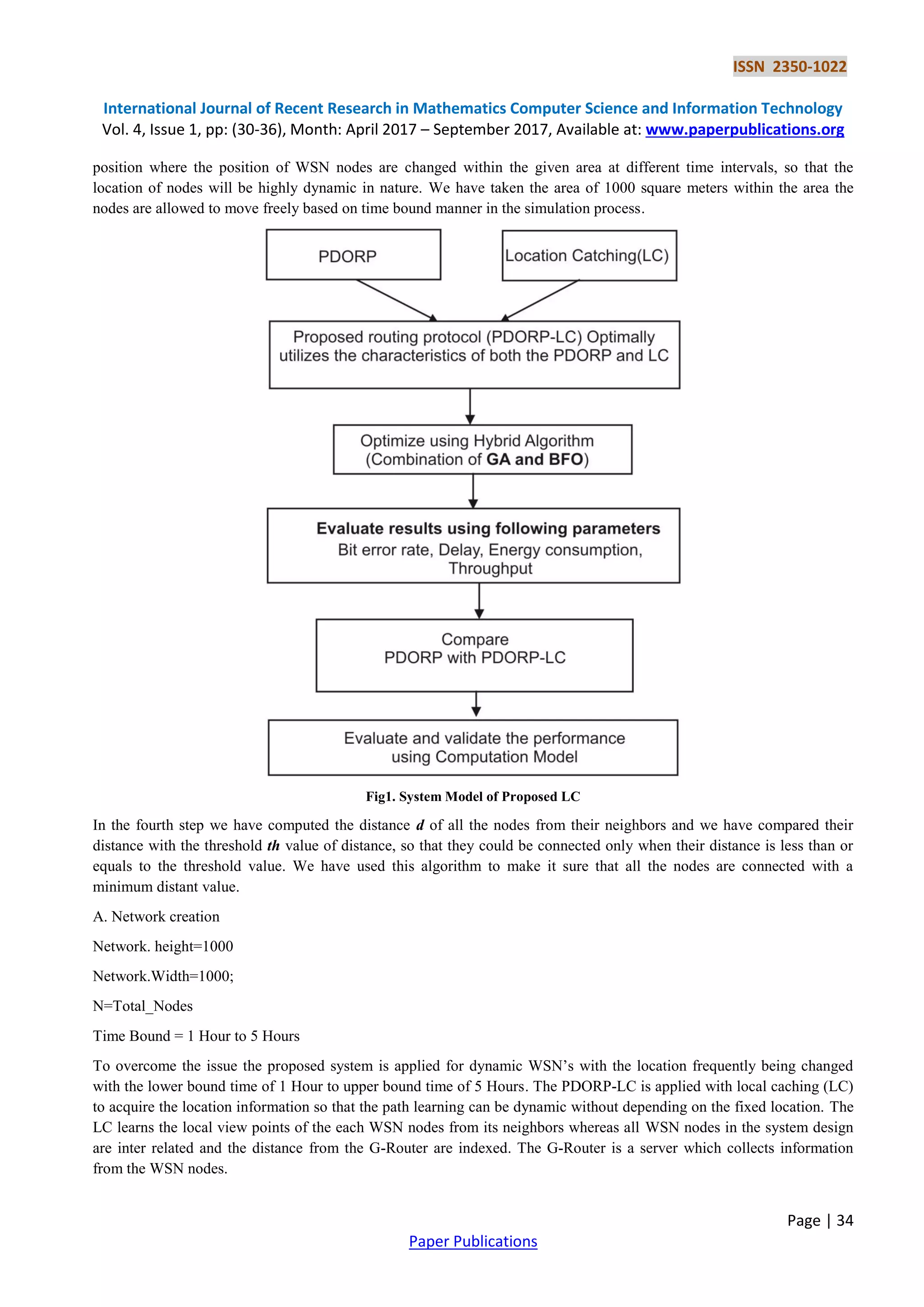The document discusses an energy-efficient routing protocol, PDORP-LC, designed for dynamic wireless sensor networks (WSNs) that frequently change locations. It integrates concepts from both proactive and reactive routing protocols to optimize energy consumption, reduce end-to-end transmission delay, and lower bit error rates compared to existing methods. Various optimization approaches for WSN design are explored, emphasizing the need for adaptive solutions in environments with varying node dynamics.

![ISSN 2350-1022
International Journal of Recent Research in Mathematics Computer Science and Information Technology
Vol. 4, Issue 1, pp: (30-36), Month: April 2017 – September 2017, Available at: www.paperpublications.org
Page | 31
Paper Publications
using the dynamic WSN’s with the location frequently being changed. PDORP-LC is applied with local caching (LC) to
acquire the location information so that the path learning can be dynamic without depending on the fixed location
2. RELATED WORK
2.1 A Genetic Algorithm for Shortest Path Routing Problem and the Sizing of Populations:
This paper presents a genetic algorithmic approach to the shortest path (SP) routing problem. Variable-length
chromosomes (strings) and their genes (parameters) have been used for encoding the problem. The crossover operation
exchanges partial chromosomes (partial routes) at positionally independent crossing sites and the mutation operation
maintains the genetic diversity of the population. The proposed algorithm can cure all the infeasible chromosomes with
a simple repair function. Crossover and mutation together provide a search capability that results in improved quality of
solution and enhanced rate of convergence. This paper also develops a population-sizing equation that facilitates a
solution with desired quality. It is based on the gambler’s ruin model; the equation has been further enhanced and
generalized, however. The equation relates the size of the population, the quality of solution, the cardinality of the
alphabet, and other parameters of the proposed algorithm. Computer simulations show that the proposed algorithm
exhibits a much better quality of solution (route optimality) and a much higher rate of convergence than other
algorithms. The results are relatively independent of problem types (network sizes and topologies) for almost all source–
destination pairs. Furthermore, simulation studies emphasize the usefulness of the population-sizing equation. The
equation scales to larger networks. It is felt that it can be used for determining an adequate population size (for a desired
quality of solution) in the SP routing problem. Index Terms—Gambler’s ruin model, genetic algorithms, population size,
shortest path routing problem.
2.2 Genetic algorithm based schedulers for grid computing systems:
In this paper we present Genetic Algorithms (GAs) based schedulers for ef- ficiently allocating jobs to resources in a
Grid system. Scheduling is a key problem in emergent computational systems, such as Grid and P2P, in order to benefit
from the large computing capacity of such systems. We present an extensive study on the usefulness of GAs for
designing efficient Grid schedulers when makespan and flowtime are minimized. Two encoding schemes has been
considered and most of GA operators for each of them are implemented and empirically studied. The extensive
experimental study showed that our GA-based schedulers outperform existing GA implementations in the literature for
the problem and also revealed their efficiency when makespan and flowtime are minimized either in a hierarchical or a
simultaneous optimization mode; previous approaches considered only the minimization of the makespan. Moreover, we
were able to identify which GAs versions work best under certain Grid characteristics, which is very useful for real
Grids. Our GA-based schedulers are very fast and hence they can be used to dynamically schedule jobs arrived in the
Grid system by running in batch mode for a short time. Keywords: Computational Grids, Scheduling, Genetic
Algorithms, Resource Allocation, Make span, Flow time, Expected Time to Compute, Benchmark Simulation Model.
2.3 Optimal PID Governor Tuning of Hydraulic Turbine Generators With Bacterial Foraging Particle Swarm
Optimization Algorithm:
To improve the quality of PID parameters of the turbine governor, bacterial foraging optimization (BFO) algorithm was
introduced. Considering the slow convergence of BFO algorithm and the good convergence of particle swarm
optimization (PSO) algorithm, a novel method named BFO- PSO algorithm was proposed. The integrated ITAE index
plus the Jcc index which weights the interaction between bacterial cells constitutes a new type of fitness function, which
can reflect the effect of bacterial swarm's mutual attraction, mutual repellence and mutual learning. Through numerical
experiments, it's found that compared to the classic BFO algorithm and the classic PSO algorithm, BFO-PSO algorithm
converges faster and can effectively improve the dynamic performance of the hydraulic turbine governing system
transients on no-load and isolated operation conditions.
2.4. Power Efficient gathering in sensor information systems:
Sensor webs consisting of nodes with limited battery power and wireless communications are deployed to collect useful
information from the field. Gathering sensed information in an energy efficient manner is critical to operate the sensor
network for a long period of time. In [3] a data collection problem is defined where, in a round of communication, each](https://image.slidesharecdn.com/energyefficientoptimalpaths-170623102406/75/Energy-Efficient-Optimal-Paths-Using-PDORP-LC-2-2048.jpg)
![ISSN 2350-1022
International Journal of Recent Research in Mathematics Computer Science and Information Technology
Vol. 4, Issue 1, pp: (30-36), Month: April 2017 – September 2017, Available at: www.paperpublications.org
Page | 32
Paper Publications
sensor node has a packet to be sent to the distant base station. If each node transmits its sensed data directly to the base
station then it will deplete its power quickly. The LEACH protocol presented in [3] is an elegant solution where clusters
are formed to fuse data before transmitting to the base station. By randomizing the cluster heads chosen to transmit to
the base station, LEACH achieves a factor of 8 improvement compared to direct transmissions, as measured in terms of
when nodes die. In this paper, we propose PEGASIS (Power-Efficient GAthering in Sensor Information Systems), a
near optimal chain-based protocol that is an improvement over LEACH. In PEGASIS, each node communicates only
with a close neighbor and takes turns transmitting to the base station, thus reducing the amount of energy spent per
round. Simulation results show that PEGASIS performs better than LEACH by about 100 to 300% when 1%, 20%, 50%
, and 100% of nodes die for different network sizes and topologies.
2.5 Energy efficient chain based cooperative routing protocol for WSN:
Here the purpose is to investigate the reduction in total transmission time and the energy consumption of wireless sensor
networks using multi-hop data aggregation by forming coordination in hierarchical clustering. Novel algorithm handles
wireless sensor network in numerous circumstances as in large extent and high density deployments. One of the major
purposes is to collect information from inaccessible areas by using factorization of the area into subareas (clusters) and
appointing cluster head in each of the subarea. Coordination and cooperation among the local nodes via relay nodes in
local cluster (By forming sub clusters) helped to serve each and every node. Routing is based on the predefined path,
proposed by new transmission algorithm. Transmission distance is minimized by using cluster coordinators for inter
cluster communication and relay nodes within the cluster. We show by extended simulations that Chain Based Cluster
Cooperative Protocol (CBCCP) performs very well in terms of energy and time. To prove it, we compare it with
LEACH, SEP, genetic HCR and ERP and found that new protocol consumes six times less energy than LEACH, five
times less energy than SEP, four time less energy than genetic HCR and three times less energy than ERP, which further
validate our work.
3. SYSTEM MODEL
A network with limited number of sensor nodes, which are randomly deployed on a 2 - dimension area. All the nodes are
homogeneous and they have initial energy ei, where ei > 0. All the nodes have one hop communication and hence they
use short range radio transmission. Transmission between two nodes is possible only when the remaining energy of nodes
is greater or equal to the threshold level of the energy. We have used the path loss model described in, which is most
popular for theoretical analysis and network simulations. We have used the same equation as used in for computation of
power reception by the distant node for distance of dist meters. Some other assumptions about the model which are as
follows:
Transmission power of node is adjusted by the node themselves and received signal strength (RSS) can be computed
easily.
Transmission and reception of packets are accomplished with the help of directional antennas.
Nodes are naïve about their location.
Nodes have the knowledge of their neighbors to transmit and receive the packets.
Every sensor node is aware of the direction as per reference to local north.
3.1 Comparison based on various parameters with varying number of sensor nodes:
3.1.1 End to End Transmission Delay: This parameter signifies the total amount of time taken by a packet from source
to destination including transmission delay, queuing delay, propagation delay and processing delay. However an increase
in the numbers of nodes also increases the difference of delay. The delay in transmission of a data packet is the amount of
time between sending data packet by source node and receipt of same at the destination node demonstrates the results for
end-to-end delay with varying number of sensor nodes. It has been observed that end to end delay for OD-PRRP increases
with increase in the number of nodes. In addition, results show that proposed routing protocol PDORP-LC marginally
outperforms than PDORP while considering low packet delivery in dynamic environment.](https://image.slidesharecdn.com/energyefficientoptimalpaths-170623102406/75/Energy-Efficient-Optimal-Paths-Using-PDORP-LC-3-2048.jpg)


![ISSN 2350-1022
International Journal of Recent Research in Mathematics Computer Science and Information Technology
Vol. 4, Issue 1, pp: (30-36), Month: April 2017 – September 2017, Available at: www.paperpublications.org
Page | 35
Paper Publications
5. ALGORITHM
LC-Pathfinding
For i=1 :Network.Simulation.Rounds
Source=Initialize.Source;
Source.Id=Node.name(source); Path=[ ]; Pathelement =2; Path[1]=Source;
Source.Packet.count=1000;
LoC_Mark[1]=d[1]+nd;
IndexD[];
Destination.Id=Node.name(Destination);
Current_cov_set_source=cov_set(source.Id,:) dest_found=0; possible_nodes=[ ];
While(dest_found!=1)
If(periodic_update)
For each all n in current_cov_set
If(x(all n)>xloc(Source.Id) && (x(all n)-xloc(Destination.Id) < 0
Possible_nodes[possiblenoedcount] = all n;
Possiblenodecount+=1;
LoC_Mark[all n] = index[n] +nd
Endif
Selection=possiblenodecount*Random;
Selected_node=Possible_nodes[selection];
Possible_Nodes=[ ]; Path(Path element) =selected_Node
Endfor
Endif
6. EXPERIMENTAL EVALUATION
The experimental evaluation is done to prove the efficiency of the proposed system is equal even the nodes or in highly
dynamic in nature. The new method is compared with the existing method in Delay, Energy consumption and Throughput
parameter.
Fig 2. Efficiency Comparison](https://image.slidesharecdn.com/energyefficientoptimalpaths-170623102406/75/Energy-Efficient-Optimal-Paths-Using-PDORP-LC-6-2048.jpg)
![ISSN 2350-1022
International Journal of Recent Research in Mathematics Computer Science and Information Technology
Vol. 4, Issue 1, pp: (30-36), Month: April 2017 – September 2017, Available at: www.paperpublications.org
Page | 36
Paper Publications
The below comparison table is used for efficiency comparison between parameters delay, energy and throughput for 200
nodes.
Parameters Delay Energy Throughput
PDORP 5.287 10.66 0.509
PDORP-LC 5.8 10.25 0.51
7. CONCLUSION
In this system an optimized routing protocol (PDORP) along with local caching (LC) is presented, which uses cache and
directional transmission concept of both proactive and reactive routing protocols in a dynamic WSN environment. The
performance of PDORP-LC has been evaluated by comparing with existing available methods PDORP and the results
indicated that it performs better in most significant parameters viz Bit error rate, end to end transmission delay, energy
consumption and throughput. The proposed work is performing in dynamic environment with the dynamic derivation of
trusted nodes.
REFERENCES
[1] Aarti Jain and B. V. Ramana Reddy.―A Novel Method of Modeling Wireless Sensor Network Using Fuzzy Graph
and Energy Efficient Fuzzy Based k-Hop Clustering Algorithm‖. Wireless Personal Communications. 2015, vol
82(1), pp. 157-181.
[2] Shallli Rani, Rajneesh Talwar, Jyoteesh Malhotra,S.H. Ahmed, M.Sarkar, & Houbing Song (2015). ―A Novel
Scheme for an Energy Efficient Internet of Things Based on Wireless Sensor Networks‖. Sensors, 15(11), pp.28603-
28626.
[3] Young-Duk Kim, Kook-Rae Cho, Hui-Sup Cho, and Dongkyun Kim. 2014. ―A Cross-Layer Channel Access and
Routing Protocol for Medical-Grade QoS Support in Wireless Sensor Networks‖. Wireless Personal
Communications, 2014, vol. 77(1), pp 309-328.
[4] Akimitsu Kanzaki, Yasuhiro Nose, Takahiro Hara, & Shojiro Nishio, ―Dynamic Route Construction Based on
Measured Characteristics of Radio Propagation in Wireless Sensor Networks‖, International Journal of Advanced
Computer Science, vol. 2, No. 3, Pp. 85-98, Mar. 2012.
[5] Aarti Jain and B. V. Ramana Reddy.―A Novel Method of Modeling Wireless Sensor Network Using Fuzzy Graph
and Energy Efficient Fuzzy Based k-Hop Clustering Algorithm‖. Wireless Personal Communications. 2015, vol
82(1), pp. 157-181.](https://image.slidesharecdn.com/energyefficientoptimalpaths-170623102406/75/Energy-Efficient-Optimal-Paths-Using-PDORP-LC-7-2048.jpg)